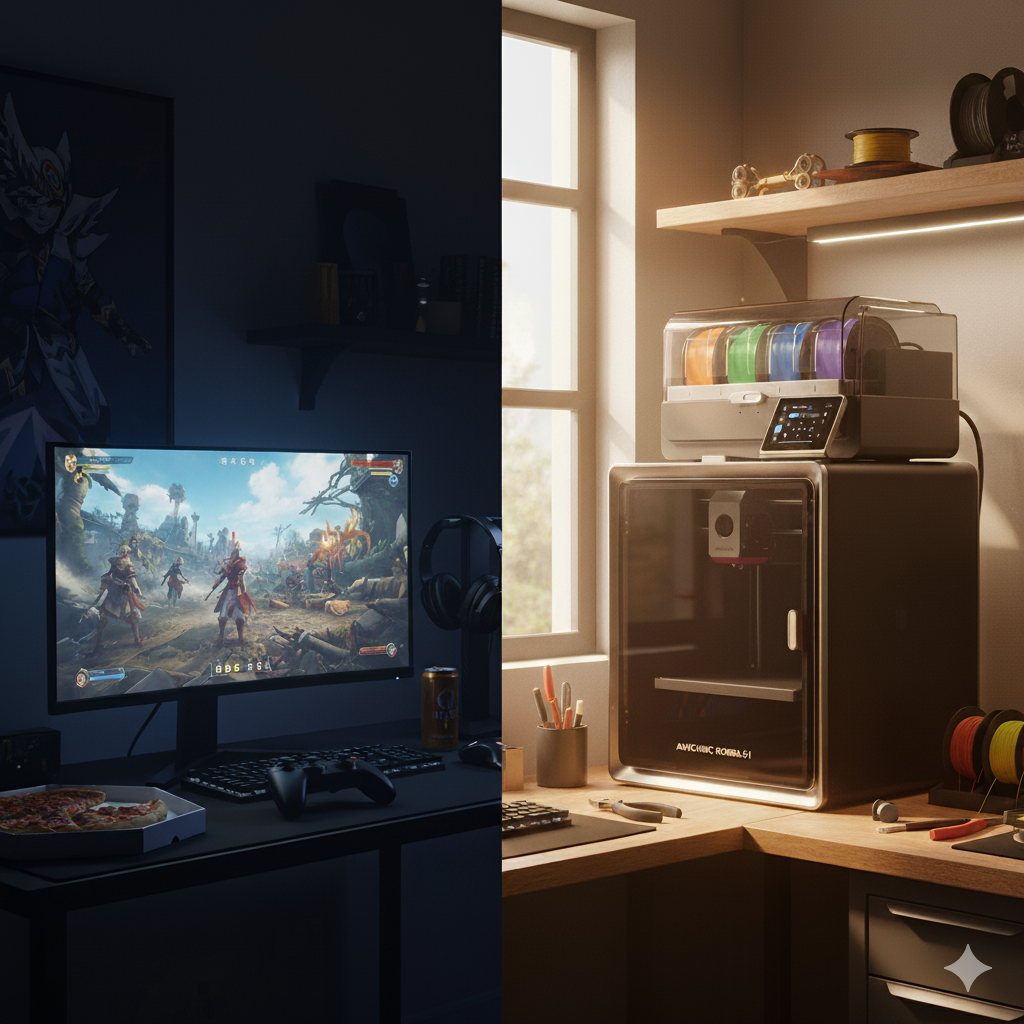Your cart is currently empty!

The Summer I Stopped Worrying About Screen Time
Summer was approaching, and I felt that familiar parental dread.
Three months. No school. My fourteen-year-old son and his computer games that consumed hours of his days. I’d always been against restrictions, believing instead in helping him develop self-regulation, guiding him toward interest in real-life activities rather than just imaginary worlds.
But the previous summer had been hard. He didn’t want to do anything but play those games. And now another long summer stretched ahead.
I wasn’t sure what would be different this time.
When Summer Approached
We’d had our first 3D printer since February. My son had been printing things, learning, experimenting. In May, we got a new printer.
But as summer approached, I still felt that familiar worry.
Yes, he was interested in 3D printing. But the games were still there, still competing for his attention. I wasn’t sure which would win when he had three months of unstructured time ahead of him.
The dependency on gaming was real. And change, I was learning, doesn’t happen overnight.
Understanding Through Creating
As my son started understanding the 3D printing concept more deeply – not just watching prints happen, but grasping how design translated to physical objects – something began to shift.
He started printing swords. Then solving printing challenges. Then he discovered the humidity problem that was affecting print quality, and he figured out how to solve it.
That’s when I saw it: he realized he had control over real problems. Problems he could actually solve. He was responsible for serious things in the physical world around him, not just virtual achievements in games.
Days would pass without him touching the games. Sometimes he still plays – sometimes even more than usual, because gaming is part of how kids socialize these days, how they connect with friends. But it’s different now. It’s not the consuming dependency it once was. It’s become one activity among many, not the only thing that interests him.
The Skills I Watched Emerge
Problem-solving became second nature. Creative thinking. Math and physics stopped being abstract school subjects and became tools he needed to make things work.
Practical skills I hadn’t expected: using a screwdriver, understanding mechanical assembly, troubleshooting technical issues.
Then the new Anycubic printer arrived.
I usually catch myself helping him with everything – the instinct to step in, to make things easier, to solve problems for him. But when that printer box arrived, he was so determined, so confident in his capabilities, that I made myself step back.
He assembled and set up that entire printer by himself.
I watched him work through it, methodical and focused, solving each step. That was the moment I felt truly impressed – not just at what he could do, but at who he was becoming. Someone who believed he could figure things out. Someone who took on challenges with confidence.
What Made This Different
I’ve tried other “educational” activities over the years. Things that were supposed to be enriching, engaging, better than screen time.
Most failed because they felt like alternatives to what he actually wanted to do. They were things I wanted him to be interested in, not things that genuinely captured his imagination.
3D printing was different because it gave him real creative power. He wasn’t consuming content someone else made. He was making things – things he designed, things that solved problems, things he could sell, things that mattered to him.
The games offered virtual achievement. 3D printing offered actual creation.
And here’s something I didn’t expect: it made spending quality time together easier. Any parent of a teenager knows this challenge – finding common ground when their interests feel foreign or impenetrable. But 3D printing? It’s fascinating at any age. I could genuinely engage with what he was doing, ask meaningful questions, share in the problem-solving. It became something we could explore together, not something I had to pretend to understand.
That’s not a small difference.
A Recommendation from Both Perspectives
I want to tell every parent: buy this thing for your children.
I say this as a parent who lived through the worry of excessive gaming, who struggled with finding the balance between restriction and freedom, who wanted desperately for my son to engage with the real world.
And I say this as a specialist who has watched hundreds of students interact with 3D printing in educational settings.
This is a real game-changer.
Not because it magically eliminates screen time – my son still has screens in his life, still plays games sometimes. But because it offers something genuinely compelling in the physical world. Something that develops real skills: problem-solving, creative thinking, technical understanding, business sense, confidence.
The investment isn’t just in a machine. It’s in giving your child tools to create, to solve problems, to build something real. It’s in watching them develop the kind of self-regulation that can’t be imposed from outside – the kind that comes from finding something they genuinely care about making.
What Changed for Us
That summer I was dreading? It became the summer everything shifted.
Not because gaming disappeared, but because it stopped being the only thing. My son found something that engaged him just as deeply but gave him real-world skills, real accomplishments, real growth.
My worry turned to pride. Not just pride in what he created, but in watching him become someone who solves problems, takes on challenges, and believes in his capability to figure things out.
That’s worth every penny of the investment.
If you’re a parent worried about your child’s screen time, wondering how to help them engage with the real world, considering whether a 3D printer is worth it – I’m telling you from experience: it is.
Not as a replacement for everything else. But as a gateway to creation, to problem-solving, to real-world skills that matter.
As a tool that transforms “I’m bored” summers into “I’m building something” summers.
That’s the difference a 3D printer made in our home.
One response to “The Summer I Stopped Worrying About Screen Time”
-
yeah. this whole process and the growth i saw in my little brother made me respect him so much more as a human being, even though, as his big sister, i dread that cuz ew…
also. mom. was that a tsitp reference??????

Leave a Reply